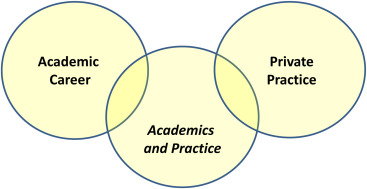We read the article by Dr. Rahul Sharma “The choice between an academic versus private practice career in cardiology: a fellow’s perspective.”
Dr. Sharma has outlined traditional differences between academic and private cardiovascular practices. However, for the past 20 years, the lines separating these 2 types of careers in medicine have gradually blurred and we would suggest that now the 2 approaches are much less distinct than outlined in this editorial. Just as heterogeneity exists in academic cardiology, it can also exist in private practice. Therefore, we would like to offer an established and alternative third model based on our experiences at the Minneapolis Heart Institute and Foundation and at many of other centers. Such institutions operate as traditional private practices while also incorporating vigorous clinical research and education arms that promote legitimate academic pursuits ( Figure 1 ).

For example, the Minneapolis Heart Institute and Foundation (at Abbott Northwestern Hospital) is not formally associated with a medical school but operates its own cardiology and subspecialty fellowships. This institution has performed in the context of an academic center associated with high patient volumes within a teaching environment incorporating mentorship for clinical investigation.
Over 25 years, the Minneapolis Heart Institute has established nationally recognized programs in the management of acute myocardial infarction, therapeutic hypothermia, aortic dissection, stem cell therapy, valvular heart disease and surgery, electrophysiology and device therapy, takotsubo cardiomyopathy, advanced cardiac imaging, structural heart disease, mechanical device therapies for heart failure, sudden death in athletes, and hypertrophic cardiomyopathy.
Academic credibility is evidenced by 272 peer-reviewed publications and 293 scientific presentations at the national cardiology meetings in 2013, 2014, and the first 6 months of 2015. These numbers dwarf those from many traditional academic university centers.
Therefore, our experience requires that we dispute the myth implicit in Dr. Sharma’s assertion that the possibility for academic cardiology performance and exposure to high patient volumes and specialized procedures are concentrated at (or limited to) university programs. The opposite is often the reality, and it is, therefore, no longer reasonable to believe in the pure binary “academic versus practice” model. A novel alternative model is now available that combines high-level practice with academics and in the process provides a myriad of career choices.
References
- 1. Sharma R.: The choice between an academic versus private practice career in cardiology: a fellow’s perspective. Am J Cardiol 2015; 115: pp. 1462-1465
- 2. Fuster V.: A journey toward converging 3 passions: research, patient care, and education. J Am Coll Cardiol 2014; 64: pp. 2064-2065
- 3. Henry T.D., Sharkey S.W., Burke M.N., Chavez I.J., Graham K.J., Henry C.R., Lips D.L., Madison J.D., Menssen K.M., Mooney M.R., Newell M.C., Pedersen W.R., Poulose A.K., Traverse J.H., Unger B.T., Wang Y.L., and Larson D.M.: A regional system to provide timely access to percutaneous coronary intervention for ST-elevation myocardial infarction. Circulation 2007; 116: pp. 721-728
- 4. Mooney M.R., Unger B.T., Boland L.L., Burke M.N., Kebed K.Y., Graham K.J., Henry T.D., Katsiyiannis W.T., Satterlee P.A., Sendelbach S., Hodges J.S., and Parham W.M.: Therapeutic hypothermia after out-of-hospital cardiac arrest: evaluation of a regional system to increase access to cooling. Circulation 2011; 124: pp. 206-214
- 5. Harris K.M., Strauss C.E., Duval S., Unger B.T., Kroshus T.J., Inampudi S., Cohen J.D., Kapsner C., Boland L.L., Eales F., Rohman E., Orlandi Q.G., Flavin T.F., Kshettry V.R., Graham K.J., Hirsch A.T., and Henry T.D.: Multidisciplinary standardized care for acute aortic dissection: design and initial outcomes of a regional care model. Circ Cardiovasc Qual Outcomes 2010; 3: pp. 424-430
- 6. Traverse J.H., Henry T.D., Pepine C.J., Willerson J.T., Zhao D.X., Ellis S.G., Forder J.R., Anderson R.D., Hatzopoulos A.K., Penn M.S., Perin E.C., Chambers J., Baran K.W., Raveendran G., Lambert C., Lerman A., Simon D.I., Vaughan D.E., Lai D., Gee A.P., Taylor D.A., Cogle C.R., Thomas J.D., Olson R.E., Bowman S., Francescon J., Geither C., Handberg E., Kappenman C., Westbrook L., Piller L.B., Simpson L.M., Baraniuk S., Loghin C., Aguilar D., Richman S., Zierold C., Spoon D.B., Bettencourt J., Sayre S.L., Vojvodic R.W., Skarlatos S.I., Gordon D.J., Ebert R.F., Kwak M., Moyé L.A., and Simari R.D.: Effect of the use and timing of bone marrow mononuclear cell delivery on left ventricular function after acute myocardial infarction: the TIME randomized trial. JAMA 2012; 308: pp. 2380-2389
- 7. Hauser R.G., Maisel W.H., Friedman P.A., Kallinen L.M., Mugglin A.S., Kumar K., Hodge D.O., Morrison T.B., and Hayes D.L.: Longevity of Sprint Fidelis implantable cardioverter-defibrillator leads and risk factors for failure: implications for patient management. Circulation 2011; 123: pp. 358-363
- 8. Hauser R.G.: Here we go again—failure of postmarketing device surveillance. N Engl J Med 2012; 366: pp. 873-875
- 9. Sharkey S.W., Lesser J.R., Zenovich A.G., Maron M.S., Lindberg J., Longe T.F., and Maron B.J.: Acute and reversible cardiomyopathy provoked by stress in women from the United States. Circulation 2005; 111: pp. 472-479
- 10. Sorajja P., Bae R., Lesser J.A., and Pedersen W.A.: Percutaneous repair of paravalvular prosthetic regurgitation: patient selection, techniques and outcomes. Heart 2015; 101: pp. 665-673
- 11. Harris K.M., Henry J.T., Rohman E., Haas T.S., and Maron B.J.: Sudden death during the triathlon. JAMA 2010; 303: pp. 1255-1257
- 12. Maron B.J., Doerer J.J., Haas T.S., Tierney D.M., and Mueller F.O.: Sudden deaths in young competitive athletes: analysis of 1866 deaths in the United States, 1980-2006. Circulation 2009; 119: pp. 1085-1092
- 13. Maron B.J., and Estes N.A.: Commotio cordis. N Engl J Med 2010; 362: pp. 917-922
- 14. Maron B.J., Rowin E.J., Casey S.A., Link M.S., Lesser J.R., Chan R.H., Garberich R.F., Udelson J.E., and Maron M.S.: Hypertrophic cardiomyopathy in adulthood associated with low cardiovascular mortality with contemporary management strategies. J Am Coll Cardiol 2015; 65: pp. 1915-1928
Stay updated, free articles. Join our Telegram channel

Full access? Get Clinical Tree


